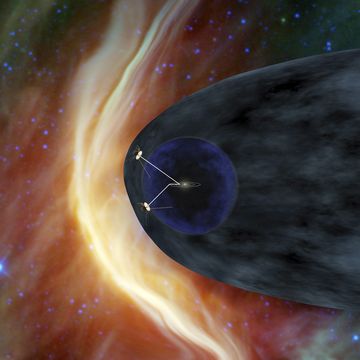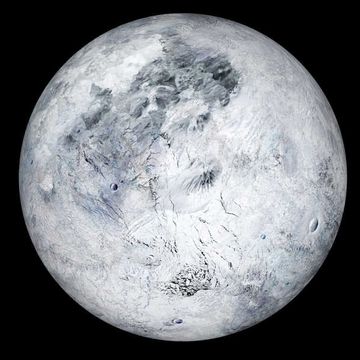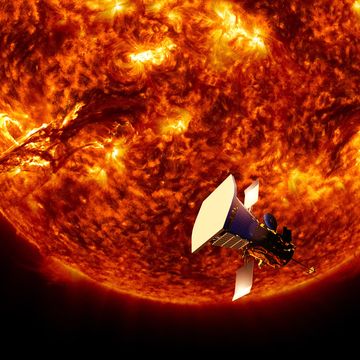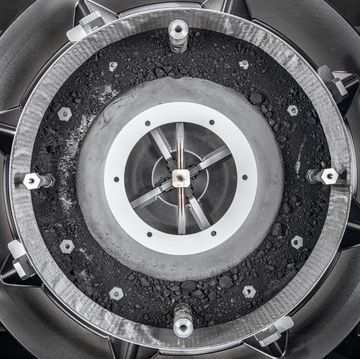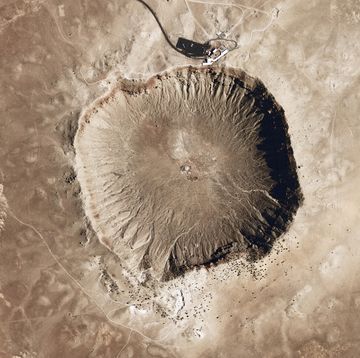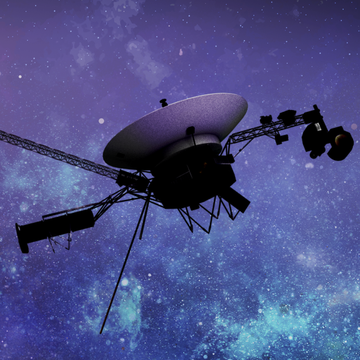A spacecraft that left Earth one year ago has returned to pay us a visit. OSIRIS-REx—the Origins, Spectral Interpretation, Resource Identification, Security, Regolith Explorer—is currently hurtling toward our planet at 13,000 mph. The probe will skirt by Earth's Southern Hemisphere on Friday at an altitude just above 11,000 miles, slingshotting around our world on its way to its primary target: the asteroid Bennu. If you have a telescope or good pair of binoculars and live in the southern part of the world, you should be able to see OSIRIS-REx and give it a wave as it whizzes by.
The spacecraft will arrive at Bennu next year, then make a low pass in 2020 to scoop up a bit of the asteroid's regolith material before leaving in 2021 and returning the sample to Earth in 2023. It's a crucial mission to visit an ancient asteroid that could tell us what the solar system looked like in its earliest days. (And by the way, Bennu has about a 1-in-2,700 chance of impacting our planet by the end of the 22nd century, which makes it doubly interesting). But OSIRIS-REx certainly is taking the long way to get to this space rock. It's orbiting all the way around the sun once, then returning to Earth for a flyby to alter its trajectory before heading on to its target.
You may have heard about NASA executing these gravity assist flybys on past space missions. So why do we bother with these roundabout routes, anyway, rather than flying a space probe right to the target? After all, as OSIRIS-REx project manager Rich Burns points out, using a gravity assist "takes a little longer to get to where you're going."
The answer is: Gravity slingshots allow engineers to send a spacecraft exactly where they need it to go, exactly when they need to be there, all while saving gas. That's worth the extra time—even if it means years.
Take, for example, the beloved Cassini spacecraft that just plunged into Saturn. It orbited the sun twice, flying by Venus twice and Earth once, before heading to the outer solar system to slingshot around Jupiter en route to Saturn. The big reason it did this, rather than flying right to the ringed planet, is that it's more efficient, Burns says. By harnessing the gravitational forces of the planets, spacecraft can arrive at a distant destination with much more of its fuel supply remaining, even if the trip takes a bit longer.
That's not the whole story of the gravity slingshot. There are two primary reasons to carry out a gravity assist. One is to change the inclination of a spacecraft's orbit, or the tilt of its orbital plane as it whirls around the sun. The other common reason is to change the energy of a spacecraft's orbit—in other words, to accelerate the probe and make it orbit in a bigger ellipse around the sun.
That first option is the reason OSIRIS-REx is stopping by. Relative to the orbit of the Earth, the asteroid Bennu's orbit is tilted at 6.2 degrees. The flyby allows the team to change the probe's orbit to match Bennu's. "It would require a tremendous amount of fuel to achieve that orbit [without the gravity assist]," Burns says. "In fact, on our current trajectory, it would far exceed the total amount of fuel... just to make this plane change that we are going to make basically for free by flying by the Earth."
This tilt may be the main reason for the flyby, but OSIRIS-REx's will still experience a large amount of acceleration during the gravity assist. "The effective velocity change imparted to the spacecraft by the angular momentum exchange with the Earth as a result of the flyby is 3.8 km/sec, or 8,500 mph," says Burns. The craft won't be traveling at a much different speed relative to the sun, however. "That change [in velocity] is absorbed into the change of the orbit inclination."
In Cassini's case, that acceleration was crucial. The spacecraft needed to fly by multiple planets to gather enough acceleration to fly all the way out to Saturn. The Juno mission currently visiting Jupiter, the MESSENGER probe that traveled to Mercury, the Voyager probes, and many more solar system missions used gravity assist maneuvers to alter the inclination or energy of their orbits, or both.
But it might not always be this way. Future interplanetary missions could forgo traditional gravity assists and get to their targets sooner, and the reason would be a big rocket like the Space Launch System NASA's currently trying to build. The Europa Clipper mission to Jupiter would use the SLS to reach a high-energy orbit that will take it to the Jupiter system in just two years. On a smaller rocket using traditional gravity assist maneuvers, the craft would need more like six years to reach Jupiter. The tradeoff, of course, is cost. Launching the SLS is expected to be incredibly expensive, about $500 million, and there is no guarantee the oft-delayed rocket will be ready to launch the Clipper.
When OSIRIS-REx arrives at Bennu, the 492-meter-across asteroid will become the smallest object ever orbited by a human spacecraft. The orbital insertion will be a painstaking process, as OSIRIS will need to fire its thrusters lightly and for just a brief amount of time for the weak gravity of the asteroid to capture. Just like the gravity assist that will happen at Earth on Friday, this will be a delicate dance of mathematical precision and engineering prowess. So when OSIRIS-REx whizzes by Earth this week to slingshot on to its ultimate target, make sure to take a moment to admire the waltz of orbital mechanics and marvel at those who have mastered it.

Jay Bennett is the associate editor of PopularMechanics.com. He has also written for Smithsonian, Popular Science and Outside Magazine.




